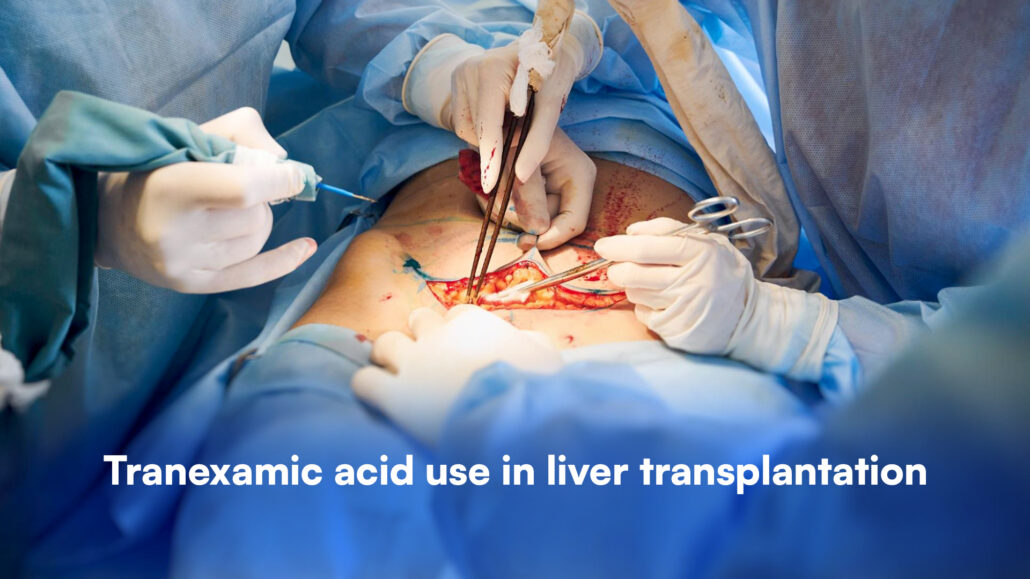
Tranexamic Acid Use in Liver Transplantation: No Significant Impact on Blood Loss or Red Blood Cell Transfusions
Liver transplantation is a high-risk procedure, often complicated by significant blood loss and the need for red blood cell (RBC) transfusions. Clinical guidelines frequently recommend using antifibrinolytic agents like tranexamic acid (TXA) to mitigate blood loss. However, the evidence supporting the effectiveness of TXA in reducing blood loss during liver transplantation has been inconsistent. The recent study by Dehne et al. 2024 investigated the effect of TXA on intraoperative blood loss and RBC transfusion requirements during liver transplantation.
Background: The Role of TXA in Liver Transplantation
Tranexamic acid is an antifibrinolytic agent that works by inhibiting the breakdown of fibrin, a key component in blood clot formation. It has been used to reduce bleeding in various surgical settings, including cardiac and orthopedic procedures. In liver transplantation, bleeding can be particularly severe due to underlying liver disease, coagulation disorders, and the complexity of the surgery itself. While TXA is commonly used during liver transplantation, there has been limited large-scale research to support its efficacy in this context definitively.
Methods
- Study Population: Adult patients undergoing orthotopic liver transplantation. Patients who had retransplantations within 30 days or died within 24 hours of surgery were excluded.
- TXA Administration: TXA was administered intraoperatively to 33.6% of the patients, with an average dose of 1.4 g.
- Primary Outcome: Intraoperative blood loss.
- Secondary Outcomes: Intra- and postoperative RBC transfusions and the occurrence of thrombotic events.
Results
- Blood Loss
The study found no significant association between TXA administration and reduced intraoperative blood loss. The median blood loss across all cases was 3,000 mL, and regression analysis indicated that TXA did not significantly impact this outcome. Other factors, such as surgery duration and recipient body mass index (BMI), were more strongly associated with blood loss.
- Red Blood Cell Transfusion
Similarly, the study found no significant difference in the number of RBC transfusions between patients who received TXA and those who did not. Most patients (82%) required intraoperative transfusions, with an average of 8.4 transfusion units administered intraoperatively and 10.6 units by postoperative day 3.
- Thrombotic Events
The incidence of thrombotic complications (HAT, PVT, and IVC thrombosis) was also analyzed. TXA use was not associated with an increased risk of these events. The overall incidence of thrombotic events was 9.8%, with 5.9% of patients experiencing HAT, 3% experiencing PVT, and 1.9% experiencing IVC thrombosis.
Discussion
This study challenges the current practice of administering TXA during liver transplantation to reduce blood loss and transfusion requirements. The lack of a significant effect raises questions about the utility of TXA in this specific surgical setting. Several possible explanations for these findings were considered:
- Hyperfibrinolysis and Self-Limitation: Hyperfibrinolysis, a condition where excessive fibrin breakdown occurs, is often seen in the early stages of liver transplantation but tends to resolve shortly after the new liver is perfused. This may limit the effectiveness of TXA in preventing blood loss during transplantation.
- Complexity of Coagulation Disorders: Patients with end-stage liver disease exhibit complex coagulation abnormalities, including both bleeding tendencies and an increased risk of thrombosis. This imbalance may limit the effectiveness of TXA and complicate its use.
Alternative Factors Influencing Blood Loss
The study identified several factors more strongly associated with blood loss than TXA use, including:
- Higher BMI was associated with greater blood loss, possibly due to the increased complexity of the surgery in larger patients.
- Longer surgeries were linked to more blood loss, emphasizing the importance of surgical efficiency in managing intraoperative bleeding.
- Fresh frozen plasma (FFP), platelets, and prothrombin complex concentrate (PCC) were all significantly associated with increased blood loss and transfusion requirements, reflecting the complexity of managing coagulation in liver transplant patients.
Implications for Clinical Practice
Based on these findings, the routine use of TXA in liver transplantation to reduce blood loss and transfusion requirements may need to be reconsidered. The study’s authors recommend that physicians exercise caution and consider individual patient factors when administering TXA. For patients with severe coagulation disorders or ongoing bleeding, TXA may still have a role, but its use should be carefully evaluated on a case-by-case basis.
For more detailed information, refer to the full article in Anesthesia & Analgesia.
Dehne S, Riede C, Feisst M, et al. Tranexamic Acid Administration During Liver Transplantation Is Not Associated With Lower Blood Loss or With Reduced Utilization of Red Blood Cell Transfusion. Anesth Analg. 2024;139(3):598-608.
Explore this topic in our newest Anesthesiology Manual: Best Practices & Case Management for more information on liver transplantation. Don’t miss out—get your copy on Amazon or Google Books.




